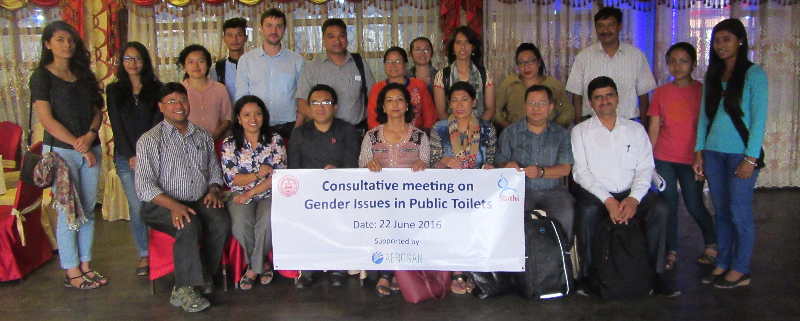- Alex Lynch

A participatory workshop on gender issues in public toilets was held in Kathmandu by GUTHI in collaboration with Kathmandu Metropolitan City with the assistance of AEROSAN on 22 June.
The workshop was made up of 16 participants (9 women, 7 men) with representatives from private sector, Kathmandu Metropolitan City, UNICEF, WaterAid, LUMANTI, GUTHI, Federation of Slums, NGO FORUM, FANSA Nepal, transgender community, and disabled & hearing-impaired community.
The goal of this workshop was to better understand the perceived issues regarding public toilets and gender in Nepal. The meeting expected to get an idea of the proposed solutions and some of the difficulties regarding implementation. The meeting teased out the following issues and gaps with the public toilets in the Kathmandu.
- Representatives from different organizations were asked to generally talk about their experiences with public toilets in Kathmandu. The feedback was all very similar: poor management, unhygienic, lack of water availability, garbage and other materials thrown into urinals and toilets, poor signage, and general poor user experience.
- Representatives were also asked to discuss issues associated with gender and public toilets. One of the main issues that was brought up was the lack of user involvement in the design process to ensure facilities are designed with the user in mind. Issues that were discussed included: no privacy, no security, graffiti on toilet that is offensive/intimidating, lack of waste bins for menstrual hygiene products. Issues were also brought up that there is complete lack of consideration for transgender community in design.
- We also discussed a number of health issues that are associated with the lack of public toilets in Nepal. The main issue that was discussed is that women often avoid using public toilets for the reasons mentioned above. A survey was conducted by the Federation of Slum with female taxi drivers and female street vendors regarding their use of public toilets. They found that these parties often minimize water intake and food intake to minimize the need to urinate or defecate. Open defecation was also discussed as an alternative to limiting food and water intake.
- Access issues for low-income users was also discussed. There is a large population of street vendors that travel from around that Kathmandu Valley into the city to sell goods. These vendors often earn a very small amount of money daily and cannot afford to pay to use toilets. This population often has no other choice but to open defecate or "hold it". We discussed the idea of potentially offering a monthly pass at a significantly lower rate.
- Disabled friendly/child friendly toilets were also an important part of the conversations. There are a few examples of good design in Nepal and consultation was key. The representative from this community spoke about the misconception of what exactly disabled friendly design is. She said that most people believe that a ramp is the only requirement.
- Finally, there was a lot of discussions regarding land access in Kathmandu. The Kathmandu Municipality spoke about the issue in some detail. They spoke about the need for the Water, Sanitation and Hygiene community in Nepal to put pressure on the Government to make this a priority (currently the municipality does not grant land).
The key point that was taken away from this meeting was the need for a participatory approach to planning and implementation of public toilets. There are currently no good examples of where this has been executed successfully here in Nepal. The participants appreciated this workshop as being the first step in that process.

